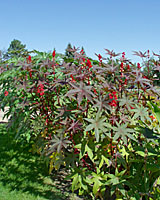Terry L. Ettinger Horticulture Consulting Services
Meeting The Needs Of Today With A Vision For The Future
Question of the Week
Growing Castor Bean Plants
 Q. Last year I grew a plant from seedlings I received
from a neighbor who, in turn had received them from a friend. I collected seeds
last fall - which look a lot like pinto beans - and tried to grow
grow them this spring, but none germinated. No one seems to know the name
of this plant? It grows six to eight feet tall and has very large,
multiple-tipped leaves. I've enclosed three pictures. Can you
identify the plant, or suggest a source to begin looking? Thank you very much for your help!
Q. Last year I grew a plant from seedlings I received
from a neighbor who, in turn had received them from a friend. I collected seeds
last fall - which look a lot like pinto beans - and tried to grow
grow them this spring, but none germinated. No one seems to know the name
of this plant? It grows six to eight feet tall and has very large,
multiple-tipped leaves. I've enclosed three pictures. Can you
identify the plant, or suggest a source to begin looking? Thank you very much for your help!
A. The plant in the pictures you've sent are of castor bean (Ricinus communis) - of castor oil and ricin poison fame. Native to areas in and near Ethiopia in the northeastern corner of the African continent, it's been cultivated for thousands of years for its beauty and the extraordinarily useful oil extracted from its seeds.
 Because of its tropical heritage, castor bean is killed freezing temperatures. However, across the southern U.S. and even as
far north as southern Illinois, the plant will reseed itself from one year to the next - just like forget-me-nots,
moss roses and crabgrass. In fact, it's so efficient at reseeding itself that it's become a widespread weed in many southern
states.
Because of its tropical heritage, castor bean is killed freezing temperatures. However, across the southern U.S. and even as
far north as southern Illinois, the plant will reseed itself from one year to the next - just like forget-me-nots,
moss roses and crabgrass. In fact, it's so efficient at reseeding itself that it's become a widespread weed in many southern
states.
If you want to grow the plant in the future, there are a number of ornamental varieties that are available from seed companies. A selection of these varieties includes 'Carmencita' (bronzy red leaves and bright red flowers), 'Impala' (a four to five foot-tall plant having reddish-green leaves that age to reddish purple), 'Sanguineus' (blood-red stems and leaves) and 'Zanzibarensis' (a large plant that has green leaves featuring white veins).
 The key to germinating this plant's seeds are to soak them in
water at least overnight, and up to 24 hours to soften the hard seed
coat. Also, once the seed have been sown, about the middle of March
here in upstate New York, it's important to keep the
peatmoss-based
potting soil between 75°F-80°F, until the seed have germinated
(three weeks, or more after they've been sown).
The key to germinating this plant's seeds are to soak them in
water at least overnight, and up to 24 hours to soften the hard seed
coat. Also, once the seed have been sown, about the middle of March
here in upstate New York, it's important to keep the
peatmoss-based
potting soil between 75°F-80°F, until the seed have germinated
(three weeks, or more after they've been sown).
The resulting seedlings can then be planted out in a spot that receives full sun all day long, after the last chance of frost has passed.
While it's often argued that this plant shouldn't be grown because of the toxicity of its seeds and other parts, it's often planted as a dramatic ornamental in public gardens, above right, and it grows as a weed in many southern states with little consequence.
Finally, if you'd like to learn more about castor bean, you can find an excellent discussion of its biology and utility on the "Waynes World" website.